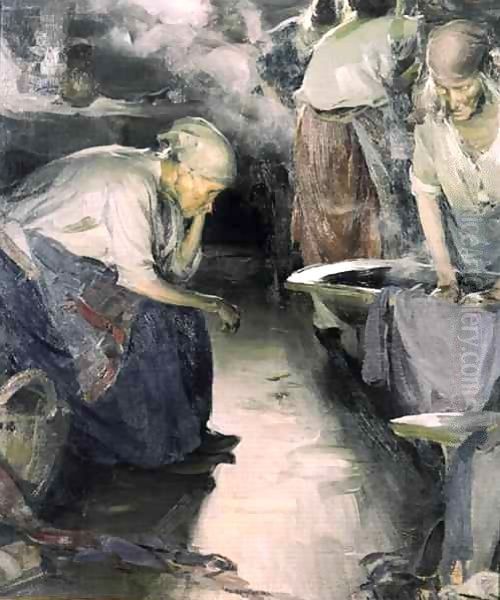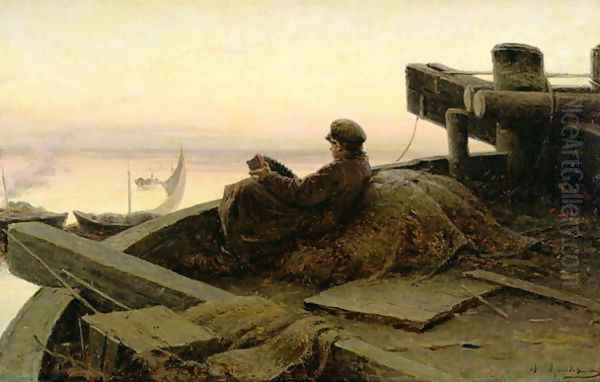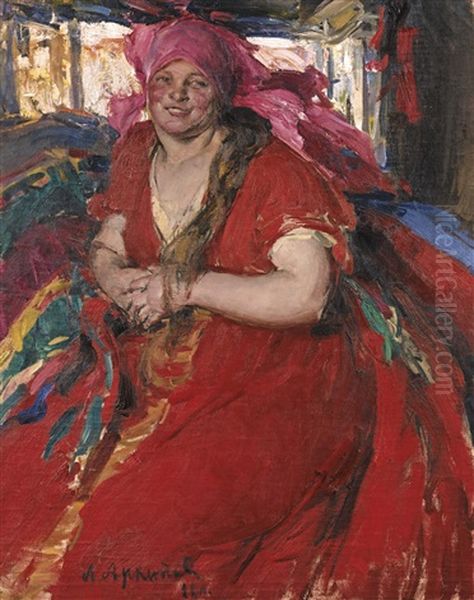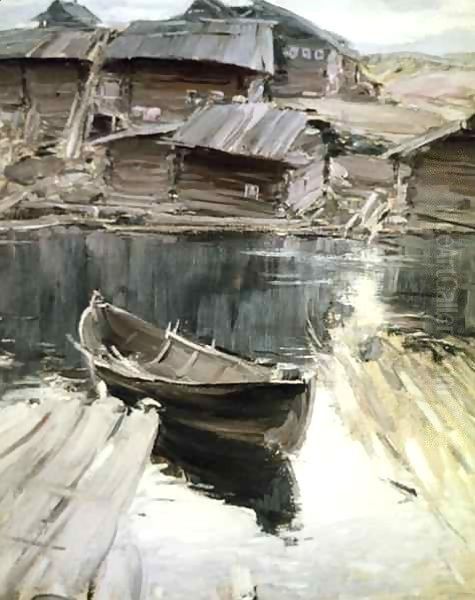
Abram Efimovich Arkhipov stands as a significant figure in the annals of Russian art, a painter whose canvases vibrantly capture the essence of rural life and the spirit of its people, particularly during the transformative period of the late 19th and early 20th centuries. His work, deeply rooted in the traditions of Russian Realism, evolved to embrace the luminous qualities of Impressionism, creating a unique artistic voice that resonated with both his contemporaries and subsequent generations. As an artist, educator, and active participant in pivotal artistic movements, Arkhipov left an indelible mark on the cultural landscape of his nation.
Humble Beginnings and Artistic Awakening
Born on August 15 (August 27, New Style), 1862, in the modest village of Yegorovo, Ryazan Governorate, Russian Empire, Abram Arkhipov (né Pyrikov) hailed from a devout and impoverished peasant family. His early life was steeped in the rhythms and realities of agricultural existence, an environment that would profoundly shape his artistic vision. Despite the hardships of their circumstances, his parents recognized and nurtured their son's burgeoning talent for drawing. This support was crucial, enabling young Abram to pursue an artistic education that was far from typical for someone of his social standing.
In 1877, at the age of fifteen, Arkhipov embarked on his formal artistic training, enrolling in the prestigious Moscow School of Painting, Sculpture, and Architecture (MSPSA). This institution was a crucible for many of Russia's greatest artistic talents, offering a curriculum that, while grounded in academic principles, was also increasingly receptive to the burgeoning Realist movement. The atmosphere at MSPSA was one of rigorous study and passionate debate, providing a fertile ground for Arkhipov's development.
Formative Education and Influential Mentors
At the Moscow School of Painting, Sculpture, and Architecture, Arkhipov studied under some of the most distinguished Russian artists of the era. His teachers included Vasily Perov, a leading figure of the Realist movement and a founding member of the Peredvizhniki (The Wanderers). Perov's work was characterized by its poignant social commentary and empathetic portrayal of the common people, themes that would resonate deeply with Arkhipov.

Another key influence was Vasily Polenov, an artist renowned for his versatile talents in landscape, historical, and genre painting. Polenov's emphasis on plein air painting and his nuanced understanding of light and color likely contributed to Arkhipov's later explorations in this domain. Vladimir Makovsky, a master of genre scenes depicting the everyday life of various social classes with a keen eye for detail and character, also played a significant role in shaping Arkhipov's observational skills. Furthermore, Alexei Savrasov, a pioneer of the Russian lyrical landscape, taught Arkhipov to perceive and convey the subtle, poetic beauty of the native Russian countryside. These mentors, each with their distinct strengths, provided Arkhipov with a comprehensive artistic foundation.
Seeking to broaden his horizons, Arkhipov briefly attended the Imperial Academy of Arts in St. Petersburg from 1883. He spent approximately two years there, from 1884 to 1886, before returning to Moscow to complete his studies at the MSPSA, graduating in 1888. While the Imperial Academy offered a more rigidly academic approach, his time there exposed him to different artistic currents and perspectives, further enriching his artistic education. His return to Moscow signaled a commitment to the artistic environment that had first nurtured his talent.
The Peredvizhniki and the Voice of Realism
A pivotal moment in Arkhipov's career came with his association with the "Society for Traveling Art Exhibitions," more commonly known as the Peredvizhniki or The Wanderers. This influential group, founded in the 1860s by artists like Ivan Kramskoy and Grigory Myasoyedov, sought to break free from the academic constraints of the Imperial Academy and bring art to a wider audience across Russia. They championed Realism, focusing on depicting contemporary Russian life, its social issues, and the beauty of the Russian landscape with truthfulness and empathy.
Arkhipov officially joined the Peredvizhniki in 1891 (some sources state 1890). His artistic concerns, particularly his focus on peasant life and his sympathetic portrayal of ordinary Russians, aligned perfectly with the movement's ideals. His participation in their traveling exhibitions allowed his work to be seen throughout the provinces, contributing to the democratization of art that the Peredvizhniki advocated. He became a prominent member of the group's later generation, alongside artists like Nikolai Kasatkin, who also focused on the lives of workers and peasants. Other key figures of the Peredvizhniki whose work formed the backdrop to Arkhipov's career include the great historical painter Vasily Surikov, the master portraitist Ilya Repin, and the landscape painters Isaac Levitan and Ivan Shishkin.
Themes of Rural Life and Peasant Women
Arkhipov's oeuvre is distinguished by its profound engagement with the themes of Russian rural life. He possessed an intimate understanding of the peasantry, born from his own upbringing, and he depicted their world with an authenticity and warmth that eschewed romanticized sentimentality. His canvases are populated with scenes of daily labor, village gatherings, and quiet moments of reflection, all rendered with a deep respect for his subjects.

A particularly recurrent and celebrated theme in Arkhipov's work is the portrayal of Russian peasant women. He captured their strength, resilience, and inherent dignity, often highlighting the vibrant colors of their traditional attire. Works such as Visiting (also known as Girlfriends or At a Visit, 1886) and later pieces featuring brightly clad peasant women in festive or everyday settings showcase his ability to convey not just their physical appearance but also their inner spirit. These women are not mere picturesque figures; they are individuals imbued with life and character, central to the fabric of rural society. His famous painting The Laundresses (versions from the late 1890s and 1901) is a powerful depiction of working-class women, capturing both the arduousness of their labor and their unyielding spirit.
Artistic Style: From Realism to Luminous Impression
Arkhipov's artistic style, while firmly rooted in the Realist tradition of the Peredvizhniki, was not static. He demonstrated a remarkable ability to absorb and adapt contemporary artistic developments, most notably the influence of Impressionism. This is particularly evident in his handling of light and color, and in his increasingly free and expressive brushwork, especially in his later works.
His early paintings, such as Man Fallen from a Horse (1884) and Icon Painter (1889), demonstrate a strong command of academic drawing and a focus on narrative clarity, characteristic of the Realist school. Works like On the Volga (1889) and On the Oka River (1889) showcase his skill in genre scenes set within carefully observed natural environments, capturing the atmosphere of river life with authenticity.
As his career progressed, Arkhipov's palette brightened considerably. He became known for his use of vibrant, often joyous colors, particularly reds, which feature prominently in the festive attire of his peasant women. This can be seen in numerous portraits and genre scenes from the early 20th century, where the brilliance of the color contributes to the overall optimistic and life-affirming mood of the paintings. His brushwork also became looser and more gestural, allowing him to capture the fleeting effects of light and atmosphere with greater immediacy.
This evolution towards a more Impressionistic approach is especially apparent in his landscapes and his depictions of figures in outdoor settings. Works like Ice Has Broken Up (or Floating Ice, 1894-1895) and Homeward Bound (or The Way Home, 1896) demonstrate his growing interest in capturing the ephemeral qualities of nature and the interplay of light on surfaces. He often painted en plein air, particularly during his travels to the Russian North, where he produced a series of luminous landscapes that are considered among his finest achievements. These northern scenes are characterized by their fresh, bright colors and their evocative portrayal of the unique light and atmosphere of the region.
A Dedicated Educator and Mentor

Beyond his achievements as a painter, Abram Arkhipov was a highly respected and influential educator. In 1894, he began teaching at his alma mater, the Moscow School of Painting, Sculpture, and Architecture, a position he held for many years, continuing even after the 1917 Revolution when the school underwent various transformations. He was appointed a professor in 1898 and became an academician in the same year.
As a teacher, Arkhipov was known for his dedication to his students and his ability to nurture their individual talents. He passed on the traditions of Realist painting while also encouraging an appreciation for color and light. Many prominent Soviet artists received their training under his guidance, benefiting from his extensive knowledge and his generous spirit. His students included figures such as S.V. Gerasimov, B.V. Johanson, and A.M. Gerasimov (not to be confused with S.V.), who would go on to play significant roles in the development of Soviet art. His commitment to education ensured that his artistic principles and his passion for depicting Russian life were transmitted to a new generation of painters.
Navigating the Revolutionary Era: New Affiliations
The early 20th century was a period of immense artistic and social ferment in Russia. Arkhipov actively participated in the changing artistic landscape. In 1903, he became one of the founding members of the Union of Russian Artists, an organization that emerged from a split within the Peredvizhniki and other groups. The Union aimed to foster a broader range of artistic expression, encompassing both Realist traditions and newer tendencies, including a greater emphasis on painterly qualities and national romantic themes. Arkhipov's involvement with the Union reflected his evolving artistic interests and his desire to engage with contemporary currents.
Following the Russian Revolution of 1917, the art world underwent profound changes. Arkhipov, whose art had always focused on the lives of ordinary people, found a place within the new Soviet cultural framework. In 1924, he joined the Association of Artists of Revolutionary Russia (AKhRR). This organization, which later became the Association of Artists of the Revolution (AKhR), was the largest and most influential artistic group in the Soviet Union during the 1920s. Its members were committed to creating art that was accessible to the masses and that depicted the realities of Soviet life, often in a heroic and documentary style. Arkhipov's established reputation as a painter of peasant life aligned well with the AKhRR's focus on themes relevant to the new society.

His contributions to Russian and Soviet art were officially recognized in 1927 when he was awarded the prestigious title of People's Artist of the RSFSR (Russian Soviet Federative Socialist Republic), and later, People's Artist of the USSR. This honor underscored his status as a major figure in the nation's artistic heritage.
Masterpieces and Signature Works
Several of Abram Arkhipov's paintings have become iconic representations of Russian art from his era. The Laundresses (versions from the late 1890s, notably one around 1899, and another in 1901) is perhaps his most famous work. These paintings depict women toiling in a steamy laundry, their faces flushed and their bodies weary, yet imbued with an undeniable strength and resilience. The works are notable for their realistic portrayal of harsh labor, their dynamic composition, and Arkhipov's masterful use of light and steam to create a palpable atmosphere.
Visiting (1886), an earlier work, captures a charming scene of peasant women in colorful attire engaged in social interaction, showcasing his early interest in genre scenes and traditional peasant life. On the Volga (1889) is a fine example of his ability to integrate figures into a landscape, depicting boatmen and passengers on the iconic Russian river.
His later works, particularly those featuring peasant women in vibrant red dresses, such as Peasant Woman in a Red Dress (various versions in the 1910s and 1920s), are celebrated for their bold use of color and their joyful, life-affirming quality. These paintings, often executed with a more Impressionistic touch, radiate warmth and vitality. A Peasant Girl with a Red Jug (1927) is another example of this popular theme, showcasing his enduring fascination with the character and traditional beauty of Russian peasant women.
His landscapes, especially those from his trips to the Russian North, such as Northern Village (1902) and In the North (1912), are admired for their fresh, clear light and their evocative depiction of the stark beauty of these regions. These works demonstrate his skill in plein air painting and his sensitivity to the nuances of the natural world.
Contemporaries and the Artistic Milieu

Arkhipov's career unfolded within a rich and dynamic artistic environment. His teachers – Vasily Perov, Vasily Polenov, Vladimir Makovsky, and Alexei Savrasov – were all major figures who shaped the course of Russian Realism and landscape painting. His classmates at the MSPSA included artists who would also achieve prominence, such as Nikolai Kasatkin, known for his depictions of miners and factory workers; Andrey Ryabushkin, who developed a distinctive style focused on 17th-century Russian life; and Mikhail Nesterov, who became renowned for his lyrical religious paintings and portraits.
Within the Peredvizhniki movement, Arkhipov was a contemporary of giants like Ilya Repin, whose historical paintings and portraits defined an era; Vasily Surikov, famed for his epic canvases of Russian history; and Isaac Levitan, the master of the "mood landscape." He also worked alongside Konstantin Korovin and Valentin Serov, who, like Arkhipov, explored Impressionistic techniques while maintaining a strong connection to Russian themes. Other notable contemporaries include Apollinary Vasnetsov, who specialized in historical Moscow landscapes, and Sergei Ivanov, known for his historical and genre scenes. The interactions, shared exhibitions, and artistic debates among these figures created a vibrant milieu that spurred innovation and development in Russian art.
Legacy and Enduring Influence
Abram Efimovich Arkhipov passed away on September 25, 1930, in Moscow, at the age of 68. He left behind a significant body of work that continues to be admired for its artistic quality, its historical importance, and its heartfelt portrayal of Russian life. His paintings are held in major museum collections across Russia, Ukraine, and Belarus, including the State Tretyakov Gallery in Moscow and the State Russian Museum in St. Petersburg.
Arkhipov's legacy is multifaceted. He is remembered as a key figure in the later phase of the Peredvizhniki movement, successfully bridging the gap between 19th-century Realism and early 20th-century artistic explorations, including the influence of Impressionism. His depictions of peasant life, particularly his vibrant portrayals of peasant women, remain some of the most enduring and beloved images in Russian art, celebrated for their optimism and their celebration of national character.
As an educator, his influence extended to generations of artists who benefited from his guidance and his commitment to artistic excellence. His ability to adapt to changing artistic and political landscapes while remaining true to his core themes speaks to his resilience and his deep connection to his subject matter. The artistic tradition in his family continued with his granddaughter, Anastasia Arkhipova (also known by her married name, Alla Bedina), who became an accomplished artist and illustrator.
Conclusion
Abram Efimovich Arkhipov was more than just a painter of peasant scenes; he was a poet of everyday life, an artist who found beauty, dignity, and vitality in the world of ordinary Russian people. His journey from a poor peasant village to the heights of the Russian art world is a testament to his talent and determination. Through his luminous canvases, filled with vibrant color and empathetic observation, Arkhipov provided a window into the soul of rural Russia, creating a body of work that remains a cherished part of Russia's cultural heritage and continues to speak to audiences with its timeless humanism and artistic brilliance.